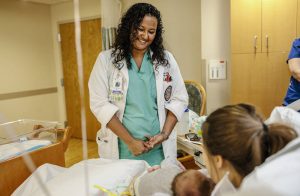
By: Melissa Korn
June 9, 2017 11:18 a.m. ET
With U.S. medical schools struggling to churn out enough doctors to meet the demand in rural and other underserved areas, overseas programs that cater to their admission rejects are helping to pick up the slack.
The international schools have long carried a stigma of being pricey, mainly for-profit and a little too close to the beach for proper studying. And health-care professionals say many still do have lax admission standards and abysmal outcomes.
But amid uncertainty over whether the pipeline of foreign doctors will slow due to tighter immigration rules under the Trump administration, some offshore institutions have polished their images as their American graduates help to fill a critical need in places like Louisiana and Wyoming.
New Jersey native Chantel Taylor was turned down by more than 20 U.S. medical schools with a 3.0 grade point average from Brown University and an “average” score on the MCAT medical-school admission test. To get her dream job as a primary-care doctor, she enrolled in a program created eight years ago specifically for Americans—in Australia.
Dr. Taylor, 29 years old, attended a joint program between the University of Queensland and the Ochsner Health System in Louisiana. Now she is about to start her second year of residency at the Louisiana State University rural family ‑medicine program in Bogalusa, La., where she does everything from deliver babies for uninsured mothers to care for elderly patients with chronic conditions.
“The work we do makes a huge impact,” she said. “There are not a lot of doctors here.”
The Association of American Medical Colleges forecasts a physician shortage of between 40,800 and 104,900 by 2030. In response, U.S. medical schools have increased first-year enrollments by more than one-quarter over the past 15 years, with 21,030 such students this year.
Still, demand for a medical education far outstrips the supply of seats on U.S. campuses. And that is where overseas medical schools are stepping in.
In 2016, 3,298 U.S. citizens from international medical schools were certified to enter American residency and fellowship programs, up from 1,858 in 2006, according to the Educational Commission for Foreign Medical Graduates, which grants the certificates. Residencies are required before doctors-in-training can become fully licensed in the U.S.
Even though students at international schools often face higher tuition and less lucrative assignments as generalist doctors after graduation, their student-loan default rates are extremely low, often under 2%, according to government statistics.
Studying medicine overseas can be a risky move, since only about 54% of American students in foreign medical schools are accepted into a U.S. residency program the first time around, compared with about 94% for U.S. students in domestic programs, according to the National Resident Matching Program, which matches medical-school students with hospitals.
A few of the schools outperform when it comes to getting students into residency programs at U.S. teaching hospitals. UQ-Ochsner, a nonprofit institution, this year achieved a residency match rate of 95%. And graduates from for-profit Ross University Medical School in Dominica, American University of the Caribbean School of Medicine in St. Maarten and St. George’s University School of Medicine in Grenada, along with a handful of others, regularly post residency match rates over 85%.
“You have high-quality candidates that come from all walks of programs,” said Stephen Knohl, internal medicine residency program director at SUNY Upstate Medical Center in Syracuse, N.Y. “You have to take a chance.”
Dr. Knohl knows the dreary central New York city isn’t a top destination for most medical-school graduates, so he casts a wide net. Nearly half of the 59 first-year residents starting at the program this summer are U.S. citizens from Caribbean medical schools.
He said he has seen “no distinct difference” between the students he brings in from U.S. or international schools.
Of aspiring doctors who applied for residency matches in 2016, 15% were U.S. citizens who attended foreign medical schools, nearly double the share of such candidates in 2000, according to the match program.
These days, the overseas schools are becoming a magnet for students interested in general practice or working in rural areas. Dr. Leonardo Seoane, head of school at UQ-Ochsner, said clinical rotations in Haiti and the Ninth Ward in New Orleans are a draw, as is exposure to Australia’s general-practitioner-centered system.
Ross and American University of the Caribbean, both owned by the publicly tradedAdtalem Global Education Inc., have been focusing their messaging in recent years on how their graduates fill coverage gaps in places like Nevada, Wyoming and Tennessee.
“Someone who wants to be a plastic surgeon is probably not heading here,” said Neal Simon, president of the American University of Antigua College of Medicine. The for-profit school matched 85% of its students into residencies over the past four years, the vast majority in internal and family medicine.
Lindsey Ling said she knew which career paths would be available when she signed up for Ross in Dominica—and that was fine, since she went to medical school with the intention of someday taking over her father’s family-medicine practice near Tampa.
Dr. Ling, a resident at St. Vincent’s Medical Center in Jacksonville, Fla., has colleagues who attended Caribbean schools and met her husband, an anesthesiology resident at the University of Miami, at Ross.
“It makes you work harder to be noticed,” Dr. Ling said of the negative connotations associated with international graduates. “But some of the stigma is fading away. We’re making a name for ourselves.”
Photo Caption: Chantel Taylor, a New Jersey native, attended medical school in Australia and is about to start her second year of residency at a program in Bogalusa, La. Above, Dr. Taylor checks on a patient and her newborn son at Our Lady of the Angels Hospital in Bogalusa. PHOTO:WILLIAM WIDMER FOR THE WALL STREET JOURNAL
Full article: https://www.wsj.com/articles/overseas-medical-schools-offer-remedy-for-shortage-of-u-s-doctors-1497021507